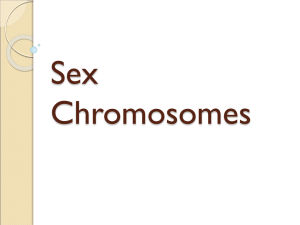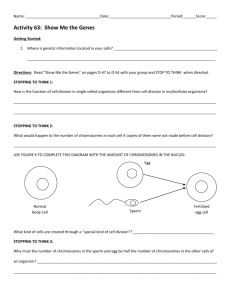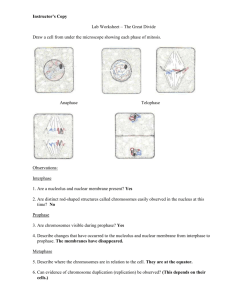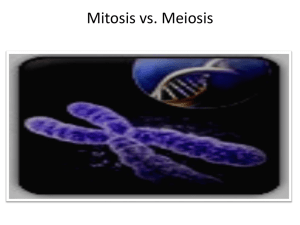3.3.1 Chromosomes Requirements # Title Details Where
advertisement
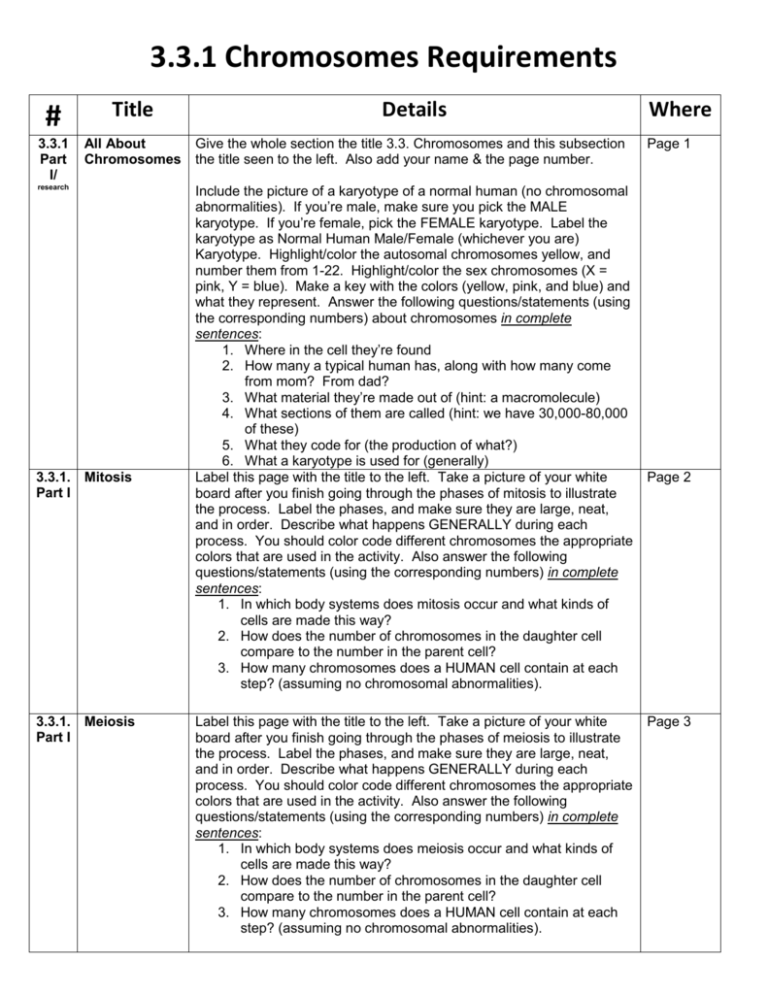
3.3.1 Chromosomes Requirements # Title 3.3.1 Part I/ All About Chromosomes research 3.3.1. Mitosis Part I 3.3.1. Meiosis Part I Details Give the whole section the title 3.3. Chromosomes and this subsection the title seen to the left. Also add your name & the page number. Include the picture of a karyotype of a normal human (no chromosomal abnormalities). If you’re male, make sure you pick the MALE karyotype. If you’re female, pick the FEMALE karyotype. Label the karyotype as Normal Human Male/Female (whichever you are) Karyotype. Highlight/color the autosomal chromosomes yellow, and number them from 1-22. Highlight/color the sex chromosomes (X = pink, Y = blue). Make a key with the colors (yellow, pink, and blue) and what they represent. Answer the following questions/statements (using the corresponding numbers) about chromosomes in complete sentences: 1. Where in the cell they’re found 2. How many a typical human has, along with how many come from mom? From dad? 3. What material they’re made out of (hint: a macromolecule) 4. What sections of them are called (hint: we have 30,000-80,000 of these) 5. What they code for (the production of what?) 6. What a karyotype is used for (generally) Label this page with the title to the left. Take a picture of your white board after you finish going through the phases of mitosis to illustrate the process. Label the phases, and make sure they are large, neat, and in order. Describe what happens GENERALLY during each process. You should color code different chromosomes the appropriate colors that are used in the activity. Also answer the following questions/statements (using the corresponding numbers) in complete sentences: 1. In which body systems does mitosis occur and what kinds of cells are made this way? 2. How does the number of chromosomes in the daughter cell compare to the number in the parent cell? 3. How many chromosomes does a HUMAN cell contain at each step? (assuming no chromosomal abnormalities). Label this page with the title to the left. Take a picture of your white board after you finish going through the phases of meiosis to illustrate the process. Label the phases, and make sure they are large, neat, and in order. Describe what happens GENERALLY during each process. You should color code different chromosomes the appropriate colors that are used in the activity. Also answer the following questions/statements (using the corresponding numbers) in complete sentences: 1. In which body systems does meiosis occur and what kinds of cells are made this way? 2. How does the number of chromosomes in the daughter cell compare to the number in the parent cell? 3. How many chromosomes does a HUMAN cell contain at each step? (assuming no chromosomal abnormalities). Where Page 1 Page 2 Page 3 3.3.1. Inheritance Part Through II Generations Label this page with the title to the left. Include a legend showing the alleles for the 3 disorders. Page 4 Make a pocket for your “dad” chromatids and one for your “mom” chromatids (if you’re doing a digital version, take a picture of and label each of these, then include this with your document). Also include the following tables, filled in (these data tables are found with the 3.3 pictures): Parents—Genotypes and Phenotypes First Child—Genotypes and Phenotypes Second Child—Genotypes and Phenotypes Class Data 3.3.1. Genetic Terms (Definitions) Label this page with the title to the left. Include each of the following vocabulary terms, a picture for each term to help illustrate that term’s meaning, and write what the term means in your own words. Terms to include are: Allele Homologous (use ROOTS to help) Gene Genotype (use ROOTS to help) Mutation Pedigree Phenotype (use ROOTS to help) Recessive Dominant Page 5 3.3.1. Genetic Terms Add’l Concept Map Label this page with the title to the left. Make a concept map about the relationship between chromosomes, genes, and DNA (the info for this is one of the attachments with A 3.3.1). The map must include the following 14 terms: chromosomes, code, disease, DNA, genes, proteins, alleles, phenotype, genotype, recessive gene, dominant gene, mitosis, meiosis, and traits (these are the terms that should be in your bubbles). Add additional terms and connecting phrases as needed to complete your map. Remember, if you do this correctly, you should be able to read your map like a sentence! You should include at least 6 pictures of your choosing to jazz up/personalize/make connections to your concept map. Page 6







